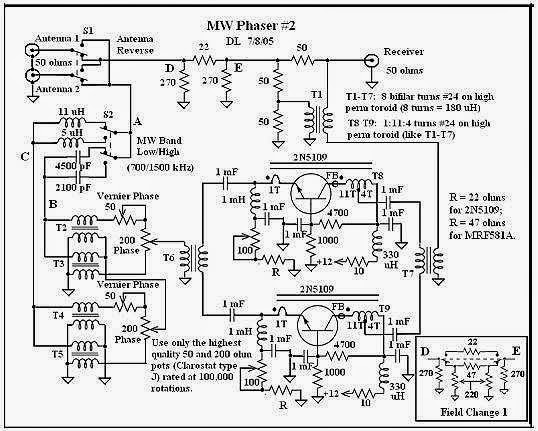Posts Tagged ‘LF’
 A 630m QRSS Test
A 630m QRSS Test
A few days ago, the power of the slow speed QRSS mode was nicely demonstrated by Mark, VA7MM (Coquitlam, BC) and Jack, VA7JX (Campbell River, BC, on Vancouver Island).
Mark was transmitting on 630m at a power of just 144mW output, while Jack was receiving on his normal 630m inverted 'L'. Mark tried various QRSS speeds ranging from QRSS3 (3 second 'dits') to QRSS60 (60 second 'dits'). One can clearly see the difference between the three speeds.
Going from the relatively slow CW rate of 6 WPM to just QRSS3 alone, produces a healthy 12db increase in signal level. Going from there to QRSS10 produces another 5db, while going all the way to QRSS60 produces a whopping 24.8db over 6 WPM CW! The trade off, of course, being the amount of time it takes to send the needed information.
In practical terms, contacts can be made relatively quickly at both QRSS3 and QRSS10. After that it becomes a bit of a chore as conditions need to be very stable for long periods of time ... as well, you'll need several hours to complete a two-way exchange.
This is over a 120 mile (192km) path but what is remarkable is the rugged nature of the path as shown here:
Although mostly over water for the second portion, the initial launch of Mark's signal is into a hellish 60 mile path of rugged coastal mountain peaks, with most of them in the 3,000 - 4,000 foot range! If this is an all groundwave path, and I suspect that it may be, it surely demonstrates the amazing groundwave capability of 630m. If there were any skywave involved, I would expect to see some fading on the signal path ... but the QRSS60 signal looks rock-solid and fade-free.
I should add that Mark's transmitting antenna is very minimal at the moment, consisting of an 80m dipole fed as a vertical 'T', tuned but not impedance-matched and ... no ground radials. Pretty remarkable actually.
Mark was transmitting on 630m at a power of just 144mW output, while Jack was receiving on his normal 630m inverted 'L'. Mark tried various QRSS speeds ranging from QRSS3 (3 second 'dits') to QRSS60 (60 second 'dits'). One can clearly see the difference between the three speeds.
Going from the relatively slow CW rate of 6 WPM to just QRSS3 alone, produces a healthy 12db increase in signal level. Going from there to QRSS10 produces another 5db, while going all the way to QRSS60 produces a whopping 24.8db over 6 WPM CW! The trade off, of course, being the amount of time it takes to send the needed information.
In practical terms, contacts can be made relatively quickly at both QRSS3 and QRSS10. After that it becomes a bit of a chore as conditions need to be very stable for long periods of time ... as well, you'll need several hours to complete a two-way exchange.
 | |
| courtesy: https://www.google.com/earth/ |
| VA7MM - QRSS3 |
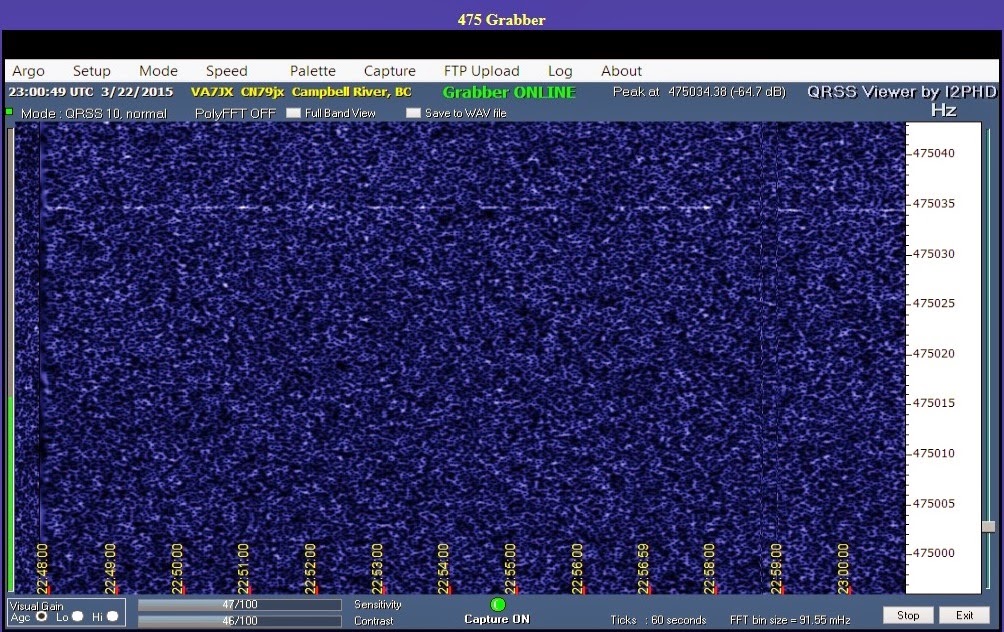 |
| VA7MM - QRSS10 |
 |
| VA7MM - QRSS60 |
 |
| courtesy: http://www.heywhatsthat.com/profiler.html |
I should add that Mark's transmitting antenna is very minimal at the moment, consisting of an 80m dipole fed as a vertical 'T', tuned but not impedance-matched and ... no ground radials. Pretty remarkable actually.
 Low Noise Vertical Follow Up
Low Noise Vertical Follow Up
 The recent posting by BCB / NDB DXer, Steve Ratzlaff (AA7U in OR), describing the poor performance of his initial LNV, prompted another round of valuable discourse on the Yahoo NDBlist Group. Steve indicated that his new 40' LNV was virtually deaf compared to his loop and active whip. ... until he rewound the transformers.
The recent posting by BCB / NDB DXer, Steve Ratzlaff (AA7U in OR), describing the poor performance of his initial LNV, prompted another round of valuable discourse on the Yahoo NDBlist Group. Steve indicated that his new 40' LNV was virtually deaf compared to his loop and active whip. ... until he rewound the transformers."I've fixed the very low sensitivity of my 40 foot LNV. The transformer
needed more turns for my particular setup--that made all the difference
in the world. I'm also using coax cable, not twin lead--that apparently
makes a big difference in the proper transformer turns ratio too. But
the LNV with preamp is now about the same sensitivity as the active whip.
My transformer primary uses 110 turns, to give good reactance at
the low end of the NDB band. I started with 21 turns on the secondary,
tuned to my local beacon LGD on 296 and looked at the signal level,
removing two turns each time until I got to 8 turns. A broad peak was
with 16 turns which is what I used for the final secondary turns. That's
a turns ratio of 110/16 = 6.875.
Total coax run from the mast to the middle of the home is about
135 feet where it enters the home.
I did some ground rod checks for signal level too. I have 3 ground rods
installed at the LNV--6 foot, 4 foot and a short 2 foot. I started out
with all three connected and took a reference signal reading, then just
the 6 foot; then just the 4 foot and then just the 2 foot. Signal level
dropped several tenths of a decibel for the 2 foot rod and was the same
for the 4 and 6 foot rods by themselves and for all 3 rods connected. So
my particular setup likes something a little longer than 2 feet for the
ground rod. I'll leave all three rods connected for now since they're
already in place.
The LNV being in a different location is now quieter on some lower end
signals where the active whip is noisy due to the whip being closer to
AC power--a nice thing. The low end 195-205 kHz especially are often
unusable due to noise; the LNV is much quieter for those, apparently due
to it being 100 feet farther from the AC power at the home.
So, the bottom line is my LNV is now working like it should, I believe.
I'll continue to use it and do more comparison checks since I can switch
my antennas instantly."
From Roelof, PAØRDT:
" ... I believe the term low noise vertical is a bit misleading. These verticals are only suffering less from local noise compared to loop antennas when
located close to the house.
The reason is that the vertical is receiving the electric field and
the electric field of local noise sources located in the house fall
off very quickly outside the house, especially at LF and MW.
A loop antenna does receive the magnetic field of local noise
sources and this field does not fall off close to the house.
I can demonstrate this effect here any time with my modified ALA1530
and mini-whip antenna.
"Matching" this type of vertical to the 50 ohm input of a receiver
is interesting. Connecting it directly to the receiver input, will
load the antenna too much and the voltage across the antenna
terminals will collapse.
This problem can be solved by using a high input buffer amplifier as
used in active whips or by a voltage step down transformer.
Due to imperfections in the step down transformer, e.g.
inter-winding capacitance and insufficient inductance of the
receiver tap / secondary winding, signal output will be way down
compared to an active whip of the same length, using a high input
impedance buffer amplifier.
You can use a tuned vertical to overcome this, however doing so the
broad band nature of the antenna is lost.
Living close to strong broadcast stations, which prevent the use of
active antennas, this particular type of E-probe is an excellent
alternative."
And from Anthony Casorso in CO:
"Motivated by your posts, I build a new transformer using an FT140J with 100 turns on the antenna side and a 10 tap secondary with a rotary switch to select the tap. The taps were from 8 turns to 26 turns in 2 turn increments.
After playing with it for a while, I am leaving it at 10 turns which matches the original 10 to 1 ratio. This is a tradeoff for me because I do get more output as I increase the secondary turns. The problem is that it also starts pushing my FDM-s2 SDR into overload unless I use the MW band reject filter. At the higher settings, I even get some overload with the filter, probably from strong stations near the filter edges.
Overall, the switch is much like having an adjustable attenuator. At 8 turns, the lower parts of the NDB band are just below the receiver noise floor with the resolution bandwidth I normally use so 10 seems about right.
Now that I have the switch, I can play around with it and see if there are situations where other settings work better (like on shortwave maybe)."
And finally Don, in California:
"Well, with 50% more turns (12T) on the secondary winding there is alot
more output. Around 520 kHz I was running the Perseus volume almost all
the way up - now it is about half.
I'm using ~33m 75 oHm coax from the LNV to the Perseus - no RF amp -
plenty of signal. My LNV output is about 15 - 20 dbm less according to
the Perseus than the PA0RDT and Wellbrook ALA-100 but I don't seem to be
missing any signals because of the lower "S" reading. I'm amazed that it
seems to work well so I'm trying not get tangled up in numbers. I don't
think it is possible to have a perfect match with hard wired components
and changing frequencies.
The secondary seems to need at least 8T with a 80T primary in my little
LNV experiment and 12T is better. When I get the 28ga wire I will wind a
primary of 110T to match Steve R's LNV coil with a secondary of 12T to
start with."
Of interest to note is the use by both Steve and Roelof of the RPA-1 preamp.
 |
| courtesy: www.dxengineering.com/ |
From Steve:
" I'm using a DXE RPA-1 preamp that I've modified for flat LF response. It
has about +18 dB gain. The stock preamp rolls off gain below about 300
kHz; mine is flat down to VLF. (The input transformer needs more turns,
that's all that's needed.) "
has about +18 dB gain. The stock preamp rolls off gain below about 300
kHz; mine is flat down to VLF. (The input transformer needs more turns,
that's all that's needed.) "
All good information if you are contemplating your own LNV installation.
 NDB Band Wakes Up
NDB Band Wakes Up
The LF NDB band was alive with signals from the east on Tuesday evening ... not the best I have heard but one of the better openings this winter. Nothing over the past few years can compare with the unbelievably good propagation of the last Solar Cycle minimum, so there should be some great LF propagation in the upcoming years. Remember also that listening for NDB's in the 400Khz range can be a good test of your 630m receiving system.
My nightly "go to" propagation indicators to the east are YLJ-406, in Meadow Lake, Saskatchewan and AA-365, in Fargo, on the ND/MN border. Their reported powers are 15W and 100W respectively.
YLJ's signal was a solid S9 as heard here, while AA, further to the south was also doing well, heard here.
Further to the east, 25W ZHD-399, in Dryden, Ontario, revealed itself here.
From near Montreal, ZHU-407, at 95W, made a rare appearance here, along with YMW-366, a 500-watter from Maniwaki, Quebec here.
By far the highlight of the evening (and a new catch for me) was little OO-391, at the Ottawa Municipal Airport, Ontario ... last reported to be at just 7W output! Listen here carefully for the long dash followed by the 'OO'.
Yahoo Group's NDBlist member, VE3GOP, is the beacon maintenance man for OO and many others, and will check the power tomorrow.
All of these signals were heard at ~ 9PM local time, in a 6Hz filter using the Perseus SDR and my 10' x 20' active loop.
The previous morning had some of the year's best propagation to Alaska so far ... that direction has been dismal ... with the following NDB's heard (mostly 25-watters) in the pre-dawn hours:
03 10 1300 529 SQM Level Island AK CO36
03 10 1300 396 CMJ Ketchikan AK CO45
03 10 1300 391 EEF Sisters Island AK CO28
03 10 1300 372 FPN Fredericks Point AK CO36
03 10 1300 266 ICK Annette Island AK CO45
03 10 1300 414 IME Mt. Edgecumbe AK CO27
03 10 1300 394 RWO Kodiak AK BO37
03 10 1300 209 CYT Yakataga AK BP80
03 10 1300 390 HBT Sand Point AK AO95
03 10 1300 358 SIT Sitka AK CO26
03 10 1300 350 VTR McGrath AK BP22
03 10 1100 338 CMQ Campbell Lake AK BP41
03 10 1100 233 ALJ Johnstone Point AK BP60
03 10 1100 212 CGL Coghlan Island AK CO28
03 10 1100 223 AFE Kake AK CO36
03 10 1100 229 AKW Klawock AK CO35
03 10 1100 283 DUT Dutch Harbor AK AO63
03 10 1100 245 HNS Haines AK CO29
03 10 1300 347 DJN Delta Junction AK BP74
03 10 1100 411 ILI Iliama AK BO29
03 10 1100 277 ACE Homer AK BO49
03 10 1100 355 AUB King Salmon AK BO18
03 10 1100 524 MNL Valdez AK BP61
03 10 1300 382 JNR Unalakleet AK AP93
03 10 1100 281 CRN Cairn Mountain AK BP21
03 10 1100 385 EHM Cape Newenham AK AO88
03 10 1100 385 OCC Yakutat AK CO09
03 10 1300 390 AES Northway AK BP29
03 10 1100 404 GCR Cordova AK BP70
03 10 1100 525 ICW Nenana AK BP54
03 10 1300 251 OSE Bethel AK AP90
03 10 1100 341 ELF Cold Bay AK AO85
03 10 1300 248 GLA Gulkana AK BP72
03 10 1100 379 IWW Kenai AK BP40
03 10 1300 399 SRI St. George AK AO56
03 10 1300 393 TOG Togiak, AK AO99
03 10 1300 429 BTS Dillingham, AK BO08
03 10 1300 227 MHM Minchumina AK BP33
Unfortunately it looks like LF prop will be deteriorating rapidly, with the recent round of flares expecting to stir up absorption levels over the next several days ... however, HF should see the benefits of the increased sunspot activity ... maybe all is not lost after all!
My nightly "go to" propagation indicators to the east are YLJ-406, in Meadow Lake, Saskatchewan and AA-365, in Fargo, on the ND/MN border. Their reported powers are 15W and 100W respectively.
YLJ's signal was a solid S9 as heard here, while AA, further to the south was also doing well, heard here.
Further to the east, 25W ZHD-399, in Dryden, Ontario, revealed itself here.
From near Montreal, ZHU-407, at 95W, made a rare appearance here, along with YMW-366, a 500-watter from Maniwaki, Quebec here.
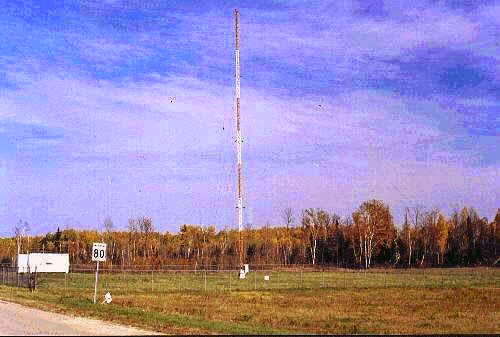 |
| YMW-366KHz Maniwaki, QC courtesy: http://www.ve3gop.com/pict.htm |
By far the highlight of the evening (and a new catch for me) was little OO-391, at the Ottawa Municipal Airport, Ontario ... last reported to be at just 7W output! Listen here carefully for the long dash followed by the 'OO'.
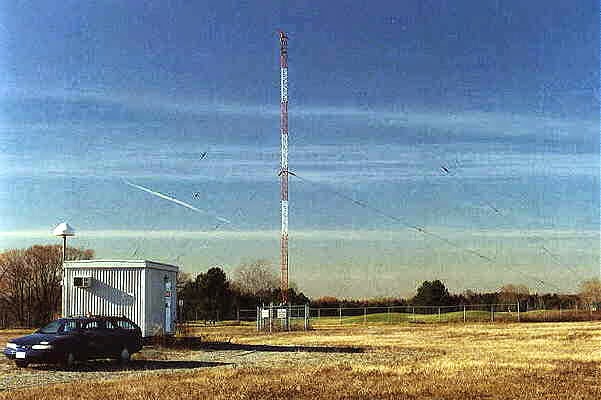 | ||
| OO-391KHz Oshawa, ON courtesy: http://www.ve3gop.com/pict.htm |
Yahoo Group's NDBlist member, VE3GOP, is the beacon maintenance man for OO and many others, and will check the power tomorrow.
All of these signals were heard at ~ 9PM local time, in a 6Hz filter using the Perseus SDR and my 10' x 20' active loop.
The previous morning had some of the year's best propagation to Alaska so far ... that direction has been dismal ... with the following NDB's heard (mostly 25-watters) in the pre-dawn hours:
03 10 1300 529 SQM Level Island AK CO36
03 10 1300 396 CMJ Ketchikan AK CO45
03 10 1300 391 EEF Sisters Island AK CO28
03 10 1300 372 FPN Fredericks Point AK CO36
03 10 1300 266 ICK Annette Island AK CO45
03 10 1300 414 IME Mt. Edgecumbe AK CO27
03 10 1300 394 RWO Kodiak AK BO37
03 10 1300 209 CYT Yakataga AK BP80
03 10 1300 390 HBT Sand Point AK AO95
03 10 1300 358 SIT Sitka AK CO26
03 10 1300 350 VTR McGrath AK BP22
03 10 1100 338 CMQ Campbell Lake AK BP41
03 10 1100 233 ALJ Johnstone Point AK BP60
03 10 1100 212 CGL Coghlan Island AK CO28
03 10 1100 223 AFE Kake AK CO36
03 10 1100 229 AKW Klawock AK CO35
03 10 1100 283 DUT Dutch Harbor AK AO63
03 10 1100 245 HNS Haines AK CO29
03 10 1300 347 DJN Delta Junction AK BP74
03 10 1100 411 ILI Iliama AK BO29
03 10 1100 277 ACE Homer AK BO49
03 10 1100 355 AUB King Salmon AK BO18
03 10 1100 524 MNL Valdez AK BP61
03 10 1300 382 JNR Unalakleet AK AP93
03 10 1100 281 CRN Cairn Mountain AK BP21
03 10 1100 385 EHM Cape Newenham AK AO88
03 10 1100 385 OCC Yakutat AK CO09
03 10 1300 390 AES Northway AK BP29
03 10 1100 404 GCR Cordova AK BP70
03 10 1100 525 ICW Nenana AK BP54
03 10 1300 251 OSE Bethel AK AP90
03 10 1100 341 ELF Cold Bay AK AO85
03 10 1300 248 GLA Gulkana AK BP72
03 10 1100 379 IWW Kenai AK BP40
03 10 1300 399 SRI St. George AK AO56
03 10 1300 393 TOG Togiak, AK AO99
03 10 1300 429 BTS Dillingham, AK BO08
03 10 1300 227 MHM Minchumina AK BP33
Unfortunately it looks like LF prop will be deteriorating rapidly, with the recent round of flares expecting to stir up absorption levels over the next several days ... however, HF should see the benefits of the increased sunspot activity ... maybe all is not lost after all!
 Phasers On Medium Wave
Phasers On Medium Wave

A recent posting on the Yahoo ndblist Group page, by veteran LF/MW DXer and front-end guru, Steve Ratzlaff (AA7U) in Oregon, described his thoughts on LF/MW antennas and his experience with phasers:
Some years back at the other place, I experimented with phasers, trying
all the various ones I could find or build. I had a long term loan of
the DXE NCC phaser as well. I compared them mostly at MW where a phaser is generally most useful; but also at LF and HF. In all cases and all
frequencies, without exception, the Dallas Lankford "MW Phaser #2" was
significantly better. I have placed that article in the ndblist Files,
under "Aerials and Technical Files" section should you have an interest
in looking at that article.
For LF use I never found any reason to use a phaser for trying to
optimize the level of a signal. Usually LF signals are short-lived and
often you only have a short time to catch an ident before it fades away.
You can easily waste 30 seconds or more just trying to optimize the
phaser; by that time the signal is usually gone. For those with a local
noise problem from a single general direction a phaser could be useful
in nulling out that noise, though of course you would lose the signals
from that direction too.
I also had room for antenna experiments, being able to compare them with
my longwire antennas. For those with the room, I believe it's hard to
beat an elevated longwire of approx. 400 feet or longer. I was very
fortunate to be able to string two E/W 1600 foot longwires, on either
side of the property about 400 feet apart and roughly parallel; and a
much shorter 400 foot N/S longwire. But even the N/S short one enabled
me to log a number of Greenland beacons (of course this was back when LF
conditions were still excellent, not like now).
Some folks have good results with the K9AY type antenna--Doug in TX has
good results using that antenna. But it's a ground-dependent antenna and
many areas don't have ground characteristics that support such antennas.
My area was one of those--the K9AY never worked very well for me. But an
elevated vertical loop worked very well, using the Wellbrook ALA100
preamp.
I had several rectangular loops up at one time, 120-150 foot
circumference using the ALA100, about 10 vertical feet distance between
the top and bottom wires to give a good capture area. These were very
sensitive at LF and a couple of times I was able to (barely) hear
distant South Pacific beacons that I was also hearing on the 1600 E/W
longwire. And of course the loop antenna is ground-independent so can be
used anywhere. It's bidirectional so can help in nulling noise too. And
such a loop doesn't take up much room as long as you can get it away
from local AC noise (which is true for all LF antennas, especially for
active whips).
Mark Connelly is a prominent east coast MW DXer and has a lot of info on
antennas and phasing on his webpage here. All his applications are primarily for MW DXing but the principles apply equally
well to LF.
The Dallas Lankford phaser article described by Steve, can also be downloaded from here.
LNV phaser, John Bellini in Colorado, also chimed-in with some additional thoughts based upon his own experience:
You do (ideally) need to have good antenna separation to have good/easy phasing of the two signals but you do not have to have two different antennas. If the antennas are too close, the noise fields can be too similar and you won't get good noise cancellation or if the antennas are too close the wavelengths of the signals compared to the antenna separation will be long and it will be a challenge to phase out a signal.
I have been using three, nearly identical, LNV antennas separated 85-110 ft, depending on which pair I use, and have had very good results using the Quantum Phaser.
A very informative discussion of backyard antennas (and phasers) suitable for LW/MWwork is described by Graham Maynard in this Medium Wave Circle article. In the author's own description:
Well, once again I say "That's it". This time my mind churning effort has been to understand and develop the results possible with simple, small back-garden, mixed loop-vertical antenna systems. It really is not as complicated as might first appear, and those willing to try could enjoy as I do, listening to other people's locals ··· Ontario ·· New York ···
These pages have been long in writing - they summarise many years of enquiring study and thoughtful co-ordination with determined and diligent empiric effort...
There's enough good bedtime reading for an evening or two here!
 CLE191 Results
CLE191 Results
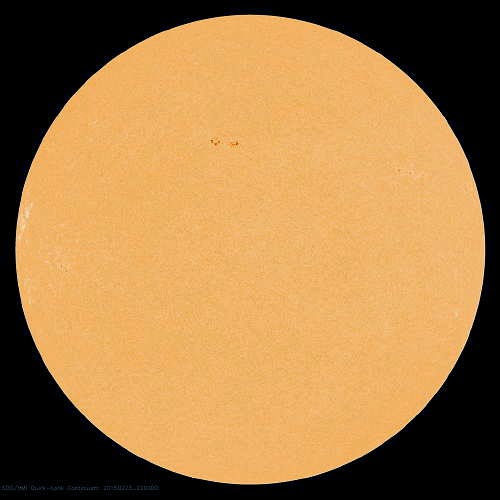 |
| http://helios.gsfc.nasa.gov/chole.html |
With my Perseus SDR taking 2-minute spectrum captures once per hour, from dusk through dawn, the short propagation lifts become quickly evident ... the majority of my loggings were made during these short windows of propagation:
21 04:00 260 ZXS Prince George, BC, CAN
21 02:00 260 YSQ Atlin, BC, CAN
22 07:00 260 AVZ Terrell, TX, USA
21 02:00 260 AP Sedalia, CO, USA
21 13:00 261 D6 Fairmont Hot Springs Apt, BC, CAN
22 09:00 263 ZQT Thunder Bay, ON, CAN
21 09:00 263 YGK Kingston, ON, CAN
21 09:00 263 YBB Kugaaruk, NU, CAN
21 13:00 263 JDN Jordan, MT, USA
21 08:00 263 3Z Russell Apt, MB, CAN
21 08:00 264 ZPB Sachigo Lake, ON, CAN
21 08:00 266 XD Edmonton, AB, CAN
21 02:00 266 VR Vancouver, BC, CAN
21 08:00 266 SL Turner, OR, USA
21 08:00 266 SAA Saratoga, WY, USA
21 08:00 266 ICK Annette Island, ALS
21 08:00 266 BZ Bozeman, MT, USA
21 13:00 268 ZWL Wollaston Lake, SK, CAN
21 08:00 269 ZW Teslin, YT, CAN
21 04:00 269 YK Castlegar, BC, CAN
21 08:00 269 UDE Delta Beach, MB, CAN
22 09:00 269 SWT Seward, NE, USA
22 09:00 269 PK Park Rapids, MN, USA
22 09:00 269 ISB Sibley Municipal Apt, IA, USA
21 08:00 269 CII Choteau Apt, MT, USA
23 08:00 510 OF Madison, NE, USA
21 10:00 512 HMY Lexington, OK, USA
21 10:00 515 SAK Kalispell, MT, USA
23 08:00 515 PN Ponca City, OK, USA
23 08:00 515 OS Columbus, OH, USA
21 10:00 515 CL Cresent Beach, WA, USA
22 09:00 516 YWA Petawawa, ON, CAN
23 08:00 521 TO Topeka, KS, USA
22 08:00 521 ORC Orange City, IA, USA
21 10:00 521 INE Missoula, MT, USA
23 08:00 524 HRD Hawthorne, TX, USA
21 09:00 525 ICW Nenana, ALS
21 09:00 529 SQM Big Level Isl, ALS
21 08:00 1725 WH2XDE/3 MA
21 08:00 472.4 VE7CNF BC
21 06:00 474 VE7BDQ BC
21 08:00 475.5 WG2XSV WA
In just a few years the Sun should be very very quiet for several winters, offering some superb LF listening once again.
 CLE191 Addendum
CLE191 Addendum
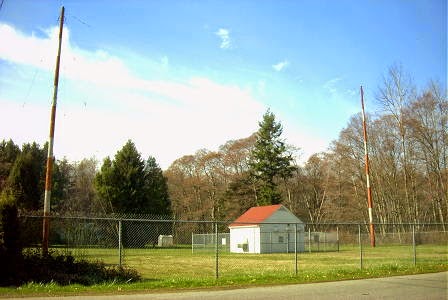 |
| WC-332KHz - White Rock, BC |
From Neil (WØYSE):
WG2XSV (experimental callsign) will be running a CW beacon on 475.475 kHz for this event.
(In fact it is already running as of 0001 UTC 20 Feb).
Power is ~1 watt ERP (+/- 1 dB) from SW Washington State.
Reports appreciated to wØyse [at] ARRL[dot] net
I'm sure Neil would be delighted to receive any heard reports from his weekend CW beacon. Remember that this CLE also covers the 630m band and CW beacons that may be operational there.
If you know of any other 630m CW beacons that will be activated, please let me know and I will post the information here.
Also, CLE reports may be mailed to either myself, the CLE Yahoo list or to Brain Keyte, CLE organizer. Brian's address is: ndbcle@gmail.com
Reports should include your exact location (Lat/Long preferred or exact Gridsquare), your full name and e-mail address in case Brian needs to send an enquiry regarding your log.
The finer-details of CLE191 may be found in Wednesday's blog.
Lets hope conditions stay nice and quiet as they appear to be doing.
 Hunting For NDB’s In CLE191
Hunting For NDB’s In CLE191
 |
| One CLE Target - 'VR' 266KHz / Vancouver Int'l Approach |
How time flies. For you low-frequency buffs, another challenge awaits. From CLE coordinator Brian Keyte (G3SIA) comes the following reminder:
"Our February Co-ordinated Listening Event will soon be here.
We'll be hunting for normal beacons in two contrasting frequency ranges.
One range also gives the possibility of hearing several amateur beacons.
As always, first-time CLE logs will be extra welcome.
Days: Friday 20 February - Monday 23 February
Times: Start and end at midday, your local time
Frequencies: 260.0 - 269.9 kHz
plus: 440.0 - 1740.0 kHz
Many of us should be able to hear beacons in both ranges, though Europe
only has a handful in the '260s'. From 440 onwards, Eastern Europe and
North Africa have several beacons and some regular UNIDs and some NDBs
can be found among Europe's Medium Wave Broadcast Stations.
Many of us are within range of some of the amateur beacons on frequencies around 470 kHz and 500 kHz - we'll be listening for ANYTHING OPERATING IN BEACON MODE, preferably with normal speed Morse.
(We ask operators who sometimes use QRSS, PSK, WSPR, etc., which need
software to receive them, to PLEASE CHOOSE THE SIMPLER MODE during
the CLE so that we shall all be able to receive and report them).
Send your CLE log to the List, preferably as a plain text email
and not in an attachment, with CLE191 at the start of its title.
Please show on EVERY LINE of your log:
# The full Date (or Day no.) and UTC (the day changes at 00:00 UTC).
# kHz (the beacon's nominal published frequency, if you know it)
# The Call Ident.
Other optional details, Location, Distance, etc., go LATER in the same
line (or in footnotes). Any extra details about UNIDs, especially strong
ones that may be near to you (maybe their approximate direction, etc.)
will help us to discover more about them. As always, please make your
log useful to old and new members alike by including your own location
and brief details of the equipment and aerial(s) you were using.
I will send an 'Any More Logs?' email at about 18:00 UTC on Tuesday
evening. From it you can check that your log has been found OK.
Do make sure that your log has arrived at the very latest by 09:00 UTC
on Wednesday 25 February.
I hope to finish making the combined results on that day."
These listening events serve several purposes. They:
- determine, worldwide, which beacons are actually in service and on-the-air so the online database can be kept up-to-date
- determine, worldwide, which beacons are out-of-service or have gone silent since the last CLE covering this range
- will indicate the state of propagation conditions at the various participant locations
- will give you an indication of how well your LF/MF receiving system is working
- give participants a fun yet challenging activity to keep their listening skills honed
Final details can be found at the NDB List website, and worldwide results, for every participant, will be posted there a few days after the event. If you are a member of the ndblist Group, results will also be e-mailed and posted there.
The very active Yahoo ndblist Group is a great place to learn more about the 'Art of NDB DXing' or to meet other listeners in your region. There is a lot of good information available there and new members are always very welcome.
If you are contemplating getting started on 630m, listening for NDBs is an excellent way to test out your receive capabilities as there are several NDBs located near this part of the spectrum.
You need not be an ndblist member to participate in the CLEs and all reports, no matter how small, are of much value to the organizers. 'First-time' logs are always VERY welcome!
Reports may be sent to the ndblist or e-mailed to either myself or CLE co- ordinator, Brian Keyte (G3SIA), whose address appears above.
Please...do give the CLE a try....then let us know what NDB's can be heard from your location! Your report can then be added to the worldwide database to help keep it up-to-date.
